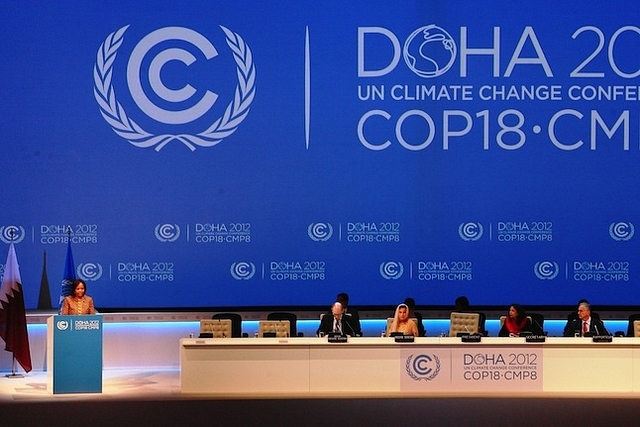
Climate Change: Lima Will See A Tough India
India is not going to pull any punches the ongoing global climate change summit. And the government promises that it will not blink under pressure from the developed world.
The world is going to get a taste of tough India-talk at the ongoing United Nations Climate Change Conference COP 20 at Lima, Peru. It seems certain that the Indian delegation, led by Union Environment Forests and Climate Change Minister Prakash Javadekar, will not be pulling any punches while articulating India’s key concerns and the need to fast-track a mechanism to create a just international system of environmental governance.
While the developed world wants to reduce carbon emissions, it does not wish to transfer technology without a premium (which goes under the garb of Intellectual Property Rights—IPRs). The grand objective of the Green Climate Fund of raising $100 billion per year by 2020 to assist developing countries’ efforts to reduce emissions, has remained almost entirely that—an objective.
In the three years since the decision taken at the Climate Change Summit at Durban, South Africa, less than $10 billion has been pledged. On 5 December, Norway announced that it will provide NOK1.6 billion ($285 million) over the next four years, bringing the total amount pledged to the Fund to about $9.95 billion.
In Lima, India is set to question why the reason for the Fund has not got activated yet.
But this does not mean that India will go back on its commitment to the environment. On the contrary, the country is likely to showcase the efforts it had made to reduce carbon emission. A book written by Narendra Modi, Convenient Action: Gujarat’s Response to Challenges of Climate Change—the title is believed to be the then Gujarat Chief Minister’s take on former US Vice-President Al Gore’s An Inconvenient Truth — provides pointers on how a determined government can do to reduce carbon emission without affecting a nation’s developmental agenda. (Indian delegation attending the Lima conference is hoping to distribute copies of the book to delegates from other countries.)
Gore’s contention had been that most political leaders wanted to avoid the “inconvenient truth” of high carbon emissions and the need to control them. Modi’s book argues that trying to reduce carbon emission makes a lot of political sense, and that small steps could lead huge reductions in carbon emission.
Javadekar has pointed out that India has already revised the target of producing 20,000 MW of solar energy to 100,000 MW by 2022. He has called this a “game changer” and pointed out that this would help save about 50 million tonnes of coal a year.
But this involves massive costs—an estimated $6.5 trillion over the next five years. India is working to build a grouping of developing countries located mostly around the Equator, which receive sunshine for at least 300 days a year, which would make coordinated efforts to harness solar energy. The effort is to manufacture solar panels and cells indigenously rather than depend on Western manufacturers whose ambitious profit motives keep prices high. “Why should there be profit from disaster?” asked Javadekar during his interaction with the media on 6 December.
The Indian delegation will also highlight efforts made to raise money for clean energy such as increasing the levy on coal from Rs 50 per tonne to Rs 100 per tonne. Termed “clean energy cess”, this will help the government collect an additional Rs 6,800 crore in 2014-15 (However, part of this will be deployed in the Ganga Action Plan).
A faster transition to clean technology will require a lot more money in the short run—perhaps upto 4-5 per cent of GDP every year.
The other major point is India’s determination to work for poverty alleviation, which means using technology and bringing its rewards within the reach of the common man. Before leaving for Lima, Javadekar said that India would speak on behalf of the world’s 400 crore poor, out of the total population of 700 crore.
India’s per capita greenhouse gas emissions is pegged at 1.7 tonne whereas the corresponding figure for developed countries has already reached 12 tonnes. “We will show a mirror to the world,” said a combative Javadekar.
India believes that developing countries must be given enough elbow room on carbon emissions till 2020, and that a new world order must be built through consensus. Stressed Javadekar, “Hum gaadi banayengey aur gaadi chalayengey, unhen jagah dena hoga” (We will manufacture cars and run the cars, they (developed countries) will have to give the carbon space).
The two-week conclave in Lima is a preparatory step for the Paris meet of 2015 which is slated to bring legally binding and universal agreements on climate.
The developed world response to Indian arguments in Lima will be crucial. But India has asserted that there will be no U-turn—the stand taken at Lima will not be reversed.
“We don’t work under pressure. We are sure of our arguments and we are confident that we will be able to convince the world,” said Javadekar, when asked if India could succumb to the world pressure.
There are already signs that the developed world has become pragmatic and understood that it must provide a level playing field to developing countries. It’s time it put its money where its mouth is and proved seriousness of intent.